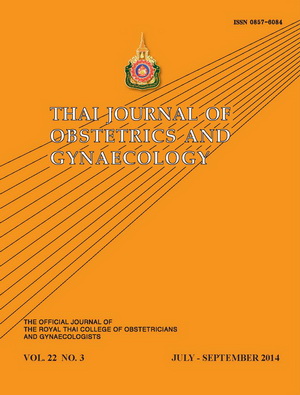Comparison of Sublingual and Vaginal Misoprostol for Termination of Early Pregnancy Failure: A randomized controlled trial
Main Article Content
Abstract
Objective: To compare the complete abortion rate, the induction-abortion time and the side effects of 800 μg misoprostol via vaginal and sublingual routes.
Materials and Methods: One hundred and twenty healthy pregnant women with early pregnancy failure from August 2012 to August 2013 at the Department of Obstetrics and Gynecology, Chonburi Hospital, were included. In Group 1 (n=60), 800 μg misoprostol with 2-3 drops of normal saline were placed in the posterior vaginal fornix. In Group 2 (n=60), 800 μg misoprostol was sublingually given. If the complete abortion did not occur, the repeated medication in the same route would be done every 6 hours for maximum of three doses in total.
Results: There was no difference in the complete abortion rate between two groups (60.0% vaginal; 68.3% sublingual, P=0.44). The mean induction-abortion time was shorter in the sublingual group compared to the vaginal group (21.1±10.2 hrs vaginal; 12.6±3.9 hrs sublingual P=0. 03). Heavy bleeding was common in the sublingual group. Side effects of both groups were similar which included nausea, fever, headache, diarrhea and abdominal pain.
Conclusion: Sublingual misoprostol was as effective as vaginal misoprostol. Induction-abortion time was shorter in the sublingual group. Most side effects of both groups were similar except heavy bleeding was more common in the sublingual group.

